Abstract
The effect of the structure of promising antioxidant agents with prospective medical use, i.e., unsubstituted and para-substituted annelated triazinylacetic acid hydrazides, on their melting points, thermal stabilities, pyrolysis and oxidative decomposition stages and the type of volatiles emitted under heating with the use of DSC and TG/DTG/FTIR/QMS methods was evaluated and discussed. The melting point of the investigated compounds increased with an enhanced number of electrons (directly correlated with their molecular weight). Melting enthalpy values were determined and presented for all the studied compounds. The pyrolysis and oxidative decomposition processes of the analysed molecules consisted of several poorly separated stages, which indicated a multi-step course of the decomposition reactions. It was found that the thermal stability of the tested compounds depended on the type of substituent at the para position of the phenyl moiety or its absence. In both atmospheres used (air and helium), the thermal stability increased in relation to R as follows: -CH3 ≤ -OCH3 < -H < -OC2H5. In an inert atmosphere, it was higher by approx. 8–18 °C than in an oxidative atmosphere. The pyrolysis was connected with the emission of NH3, HCN, HNCO, HCONH2, HCHO, CO2, CO and H2O in the case of all the tested compounds, regardless of the substituent attached. In the case of the derivative containing the para-CH3 group, para-toluidine was an additional emitted aromatic product. In turn, emissions of aniline and alcohol (methanol or ethanol) for compounds with the para-OCH3 and para-OC2H5 groups, respectively, were confirmed. In oxidative conditions, the release of NH3, NO, HCN, HNCO, HCONH2, CO2, H2O and cyanogen (for all the compounds) and para-toluidine (for the para-CH3 derivative), aniline (for para-OCH3, para-OC2H5 and unsubstituted derivatives) and acetaldehyde (for the para-OC2H5 derivative) were clearly observed. No alcohol emissions were recorded for either compound containing the para-OCH3- or para-OC2H5-substitututed phenyl ring. These results confirmed that the pyrolysis and oxidative decomposition of the investigated annelated triazinylacetohydrazides occurred according to the radical mechanism. Moreover, in the presence of oxygen, the reactions of volatiles and residues with oxygen (oxidation) and the combustion process additionally proceeded.
1. Introduction
Fused azaisocytosine-containing congeners with the acetohydrazide functional group (1–4, Figure 1), which is prone to quick oxidation, are an important class of nitrogen-rich heterocycles. All these annelated triazinylacetic acid hydrazides, including the parent compound (1, as an unsubstituted structure) and the remaining para-substituted derivatives (2–4), have been synthesised formerly, and their spectroscopic data were consistent with the assigned structures shown in Figure 1 []. These compounds have previously been subjected to extensive biological assays evaluating their reducing power and antioxidant potential, as a result of which some of them have been disclosed as new, promising antioxidant agents with prospective utility in the treatment of diseases induced by reactive oxygen species and non-radical reactive oxygen metabolites. In this class of substituted annelated triazines with the common acetohydrazide functional group, the methoxy derivative (3) has previously been reported as the most promising antioxidant agent candidate because its ability to neutralise free radicals (such as DPPH•—2,2-diphenyl-1-picrylhydrazyl radical and nitric oxide radical) and non-radical reactive oxygen metabolites (such as hydrogen peroxide) is superior or similar to that of the antioxidants in common use. Moreover, the strongest scavenger of hydrogen peroxide proved to be the ethoxy derivative (4), whose effect is better than that of standard antioxidants. For all the molecules bearing the common acetohydrazide pharmacophore (1–4), the mechanism of their antiradical action (through hydrogen atom transfer to the DPPH•) has already been established []. This makes them promising drug candidates in the preclinical phase of drug development. Such synthetic annelated triazinylacetetohydrazides may be of benefit in the prevention/therapy of various oxidative-stress-mediated diseases.
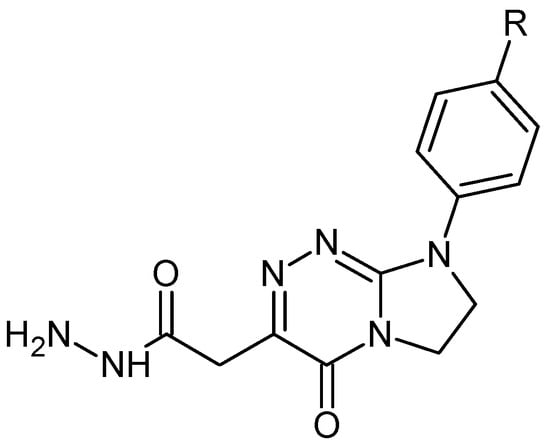
Figure 1.
The general structure of polynitrogenated annelated triazines with the common acetohydrazide functional group. The set subjected to thermal studies includes the parent compound and its para-substituted derivatives: 1: R = H; 2: R = CH3; 3: R = OCH3; 4: R = OC2H5.
There is a number of known drugs and potential molecular pharmaceutics that contain the privileged scaffold of 1,2,4-triazine or 1,2,4-triazinone [,,,]. Nevertheless, there are only few scientific reports on the thermal analysis of drugs structurally based on the 1,2,4-triazine system (lamotrigine—used for the treatment of epilepsy and bipolar disorder) [,] or with the 1,2,4-triazin-4(3H)-one nucleus incorporated into the bicyclic structure (vardenafil—used for the treatment of erectile dysfunction) []. However, surveys have shown that the thermal stability and decomposition studies have been carried out on many condensed 1,2,4-triazines containing some functional moieties, including those with importance in material science [] and pharmaceutical science [,,]. On the other hand, there is a limited number of scientific reports on the thermal analysis of small molecules containing the acetohydrazide functional group. These papers concern 2-(1H-indol-3-yl)acetohydrazide, 2-[(4-bromophenyl)amino]acetohydrazide, 2-(1H-benzotriazol-1-yl)acetohydrazide and 2-(4,6-dimethyl-1H-pyrazolo[3,4-b]pyridine-1-yl)acetohydrazide) [,,,].
However, there is a research gap in the thermal studies performed. Nothing is known about the thermal properties or the mechanism and course of thermal degradation of an important class of annelated triazinylacetic acid hydrazides, i.e., 2-[4-oxo-8-(R-phenyl)-4,6,7,8-tetrahydroimidazo[2,1-c][1,2,4]triazin-3-yl]acetohydrazides, that may have potential in the prevention of free-radical-mediated diseases. Therefore, in the preclinical phase of drug development, the detailed thermal assessment of these molecules is needed. Knowledge about the behaviour during heating of annelated triazinylacetohydrazides, so far unknown, is essential for their further characterisation, as well as for determining the conditions necessary during their storage and processing.
The present study was carried out with the goal of characterising, for the first time, the detailed thermal behaviour of this class of pharmacologically important heterobicyclic acetic acid hydrazides, employing thermal techniques such as differential scanning calorimetry (DSC) and thermogravimetric analysis (TG/DTG) coupled with Fourier-transform infrared spectroscopy and quadrupole mass spectrometry (FTIR/QMS) analysers. Simultaneous thermal analysis methods coupled with both spectroscopic and spectrometric techniques enable the reliable interpretation of the thermal behaviour and understanding of the degradation pathway of pharmaceutical substances and potential drugs []. Therefore, simultaneous and coupled thermal techniques are recommended and commonly used in thermal testing of molecular pharmaceutics and potential drug candidates. Additionally, thermal analysis technologies—which have been reviewed—are commonly applied for studying the thermal stability and thermal properties of energetic materials [].
The novelty of the present investigation is assessing the thermal stability of annelated triazinylacetohydrazides under inert and oxidative conditions and describing the thermal effects (characterised by a temperature range and enthalpy change) of all the analysed unsubstituted and para-substituted molecules, as well as identifying the volatile decomposition products emitted during their pyrolysis in helium and oxidative decomposition in air. We performed the TG/DTG/FTIR/QMS analyses under inert and oxidative conditions with the subsequent aim of elucidating the thermal decomposition mechanism and course of these heterobicyclic molecules with the common acetohydrazide functional moiety and identifying the possible degradation products in relation to the molecular structure of the particular derivative undergoing pyrolysis. In addition, we emphasised that the favourable thermal properties of annelated triazinylacetohydrazides studied may enhance their possible utility as candidates for pharmaceutical applications.
2. Results and Discussion
2.1. Melting Points Evaluated by the DSC
The melting peaks for all the tested fused triazinylacetohydrazides evaluated with the use of the DSC method are presented in Figure 2. In turn, the values of the onset (Tonset), maximum (Tmax) melting temperatures and the melting enthalpies (ΔH) are placed in Table 1. The presented results show that all the investigated molecules have only one endothermic DSC peak related to the melting process and do not undergo polymorphic transformations. In the case of compound 1, without a substituent at the phenyl moiety (i.e., the parent structure), and the molecule with a para-ethoxy group as a substituent (compound 4), one narrow melting DSC peak is observed. However, for compounds 2 and 3, bearing the para-methyl and para-methoxy substituent, respectively, at the same moiety, one DSC peak is also visible, but with a small tail at the beginning of the melting.
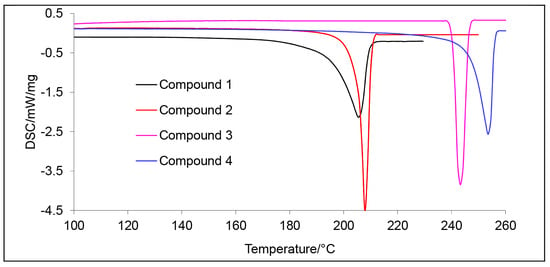
Figure 2.
The melting peaks of the tested compounds evaluated with the use of DSC (an argon atmosphere).

Table 1.
The onset (Tonset), maximum (Tmax) melting temperatures and the melting enthalpy values (ΔH) for the tested compounds evaluated with the use of DSC.
The DSC analysis shows that all tested annelated triazinylacetohydrazides are characterised by high melting points (above 195 °C). When comparing the obtained melting points, a certain relationship is visible. As the number of electrons in the molecule increases, the melting point also increases. It has been recently established (based on the developed model suitable for a fast crude estimation of melting point) that the number of electrons in a molecule is directly correlated with the molecular weight. Molecules with a higher number of electrons are able to create more polar dipoles (higher dispersion forces), and, as a result, they have higher melting points []. The compound bearing an unsubstituted phenyl moiety (1) and its derivative with the para-CH3 substitution at the phenyl ring (2) show melting points with Tmax at 205 °C and 208 °C, respectively. The para-OCH3 derivative (3) has a melting point approx. 40 °C higher than that of the parent structure (1). However, the derivative containing a para-OC2H5-substituted phenyl ring (4) shows a melting point that is about 50 °C higher than that of unsubstituted structure 1.
Moreover, as can be seen from Table 1, all the para-substituted fused triazinylacetohydrazides (2–4) show higher melting enthalpies (ΔH) as compared to an unsubstituted compound (1). The presence of a substituent at the para position of the phenyl moiety causes an increase in the ΔH values from 12.5 J/g (compound 4) to 65.9 J/g (compound 2). These results confirm that more energy must be supplied in the form of heat to change 1 g of the tested compound from a solid to a liquid in the case of all para-substituted molecules compared to unsubstituted structure 1 [,]. Among compounds with the para substitution (2–4), the dependence between ΔH values and the mass of the substituent is also noticed. As the mass of a substituent increases, the melting enthalpy decreases. This indicates that it is easier to melt derivatives containing an alkoxy group than a derivative bearing an alkyl group at the phenyl moiety.
2.2. TG/DTG Analyses (Inert Conditions)
The course of the TG and DTG curves for the tested annelated triazinylacetohydrazides gathered in inert conditions is presented in Figure 3. In addition, the course of the DSC curves collected together with the TG/DTG analysis using a DSC/TG Cp S sample carrier is shown in Figure 3. Table 2 shows the results read from the TG and DTG curves, such as the values of the initial decomposition temperatures (T5%), peak maximum temperatures (Tmax), mass losses (Δm) and the residual mass at 900 °C (rm).
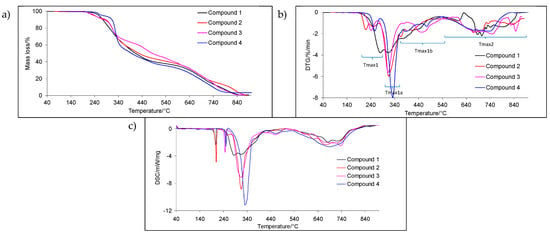
Figure 3.
The course of the TG (a), DTG (b) and DSC (c) curves for the tested compounds (inert conditions).

Table 2.
The TG/DTG data for the tested compounds (inert conditions).
The results from the TG and DTG analyses show that the tested molecules are highly thermally resistant. Their thermal decomposition begins at temperatures above 238 °C. Compounds 2 and 3, containing the para-methyl and para-methoxy group, respectively, are characterised by similar thermal stability, and have the lowest thermal stability among all the tested heterobicyclic acetohydrazides (1–4). Their thermal decomposition starts around 240 °C in inert conditions. However, the highest thermal stability among all the investigated molecules is demonstrated by compound 4, containing a para-ethoxy group at the phenyl moiety. Its thermal resistance is above 270 °C in inert conditions.
As is well visible from the presented TG/DTG curves, the decomposition process of the tested compounds is complex. It includes many simultaneous pyrolysis processes of the bonds present in the structure of the investigated molecules, which is visible in many poorly separated signals on the DTG curve. In general, it can be said that decomposition in an inert atmosphere occurs in two main stages. The first decomposition stage extends over a wide temperature range, namely, from temperature T5% to approximately 540 °C. This decomposition stage is composed of three main steps, visible at Tmax, Tmax1a and Tmax1b. The first step (Tmax) appears up to a temperature of 300 °C and is described by one or two DTG signals that are not well separated. The second step (Tmax1a) spreads from 300 °C to 360–370 °C. However, the third step (Tmax1b) happens between 360–370 °C and 550 °C, and it is composed of two main DTG signals with a low intensity that are not well separated. The mass loss (Δm1) is significant during the first decomposition stage. It is from 59.5% to 65%. The second decomposition stage takes place above the temperature of 540 °C, and it is also composed of at least three or four steps. The mass loss is from 31.8% to 40.5% in the temperature range of 540–900 °C. Basically, all the compounds decompose completely when heated to 900 °C; only a slight residue at 900 °C (0.0–3.2%) is observed. The DSC analysis also confirms that the decomposition process of the tested compounds can be divided into two main stages consisting of several steps. The first asymmetric DSC decomposition peak is visible between the temperatures of 240 °C and 550 °C. This DSC peak is an endothermic signal, which indicates the pyrolysis reactions of the bonds present in the structure of the tested compounds. The second DSC peak as a broad signal at temperatures above 550 °C is visible. It is also connected with the pyrolysis processes (an endothermic signal). In addition, the comparison of the TG/DTG and DSC results performed under the same experimental conditions indicates that the tested compounds may undergo partial decomposition immediately after their melting or during melting. This is confirmed by the presence of a low-intensity DTG signal at temperatures slightly above or equal to the melting temperatures defined as Tmax from the DSC analysis.
2.3. Decomposition Course of the Tested Compounds Evaluated with the Use of Simultaneous TG/FTIR/QMS Method (Inert Conditions)
The gaseous FTIR spectra obtained during heating of the analysed compounds and collected at Tmax1, Tmax1a, Tmax1b and Tmax2 in inert conditions are presented in Figure 4. At Tmax1, there is the attendance of two absorption peaks at 931 cm−1 and at 966 cm−1 that are characteristic bands for the emission of NH3 (deformation vibrations of N–H groups [,,,]). The formation of HNCO by the presence of the absorption peaks at 2270–2290 cm−1 [,,] is confirmed. The beginning of HCN emission (the absorption band at 713 cm−1 [,]) and volatile compounds containing the carbonyl group in their structure (the stretching vibrations of C=O at 1690–1750 cm−1) at this temperature are also visible. In addition, the attendance of the absorption bands at 708–742 cm−1 (the out-of-plane deformation vibrations of the N–H and the CAr-H), 1230–1282 cm−1 (the stretching vibrations of the C–N), 1492–1560 cm−1 (the stretching vibrations of the CAr=CAr), 1619–1690 cm−1 (the deformation vibrations of the N–H), 2856–2913 cm−1 (the stretching vibrations of the C–H) and 3008–3064 cm−1 (the stretching vibrations of the CAr-H) indicates the formation of some aromatic compounds with amine groups [,,]. In turn, the absorption band at 3332 cm−1 may confirm the creation of some compounds containing the -NHCO group in the structure. Some of the volatiles such as CO2 (the absorption bands at 2300–2365 cm−1 and 669 cm−1) and H2O (the absorption bands of OH above 3500 cm−1) are also created. As the temperature increases to Tmax1a, the intensity of the previously mentioned volatiles increases. Their evaporation up to the temperature of 540 °C is clearly visible.

Figure 4.
The gaseous FTIR spectra collected at Tmax1, Tmax1a, Tmax1b and Tmax2 (inert conditions).
If you look at the results obtained from the QMS analysis, Figure 5, it can be concluded that, in the temperature range of T5%–540 °C, the emission of isocyanic acid—HNCO (m/z ions: 43 (HNCO+), 42 (NCO+)), hydrogen cyanide—HCN (m/z ions: 27 (HCN+) and 26 (CN+)), ammonia—NH3 (m/z ions: 17 (NH3+), 15 (NH+)), formamide—HCONH2 (m/z ion: 45 (HCONH2+)), formaldehyde—H2CO (m/z ion: 30 (H2CO+), CO2 (m/z ion: 44 (CO2+) and H2O (m/z ions: 18 (H2O+), 17 (HO+)) is completely confirmed. Apart from the emission of these gases, from a temperature of approx. 305 °C to a maximum at Tmax1b, the formation of aromatic compounds is observed. The creation of aniline as a result of pyrolysis of unsubstituted compound 1 by the presence of m/z ions 93 (C6H7N+), 65 (C5H5+) and 66 (C5H6+) is confirmed []. In the case of compound 2, containing the para-CH3-substituted phenyl moiety, the formation of para-toluidine m/z ions 107 (C7NH9+) and 106 (C7NH8+) is proven. However, for compound 3, with the para-OCH3 group, interesting observations from the FTIR and QMS spectra are found. At Tmax1a, the absorption bands at 1002, 1031 and 1060 cm−1 (the stretching vibrations of the C–O), at 1195–1230 cm−1 (the deformation vibrations of the C–H), at 2817–2993 cm−1 (the stretching vibrations of the C–H) and above 3550 cm−1 (the stretching vibrations of the OH) and the presence of m/z ions 31 (CH3O+), 15 (CH3+) and 30 (CH2O+) confirm the creation of methanol as a one of the volatiles, which suggests the detachment of the -OCH3 group from the aromatic benzene ring during the pyrolysis process. As a result, as an aromatic volatile, mainly the formation of aniline is observed. A similar situation occurs in the case of pyrolysis of the para-substituted compound with the -OC2H5 group (4). The absorption bands at 1054–1066 cm−1 and 1229–1282 cm−1 (the stretching vibrations of the C–O), at 1382–1407 cm−1 (the deformation vibrations of the C–H), 2914–2967 cm−1 (the stretching vibrations of the C–H) and above 3500 cm−1 (the stretching vibrations of the OH) and the m/z ions 45 (C2H5O+), 31 (CH2OH+) and 29 (C2H5+) indicate the formation of ethanol as a result of the loss of the -OC2H5 group during pyrolysis and aniline as an aromatic decomposition product [,,].
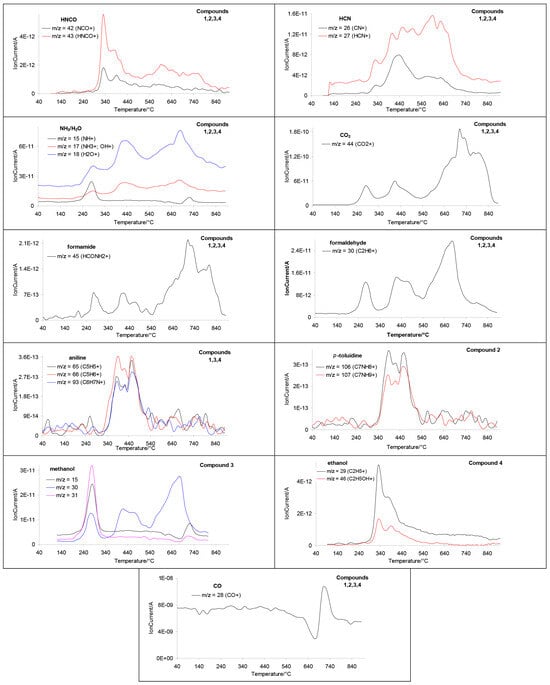
Figure 5.
The exemplary QMS spectra of volatiles formed during pyrolysis of the tested compounds.
Taking into account the experimental and theoretical mass loss in the first two decomposition steps (between T5% and Tmax1a), Table 3, the molar mass of the tested compounds and the type of the emitted volatiles, it can be assumed that, in these decomposition steps, mainly the symmetric cleavage of N–N and N–C bonds takes place, combined with the detachment of fragments containing the 2-cyanoacetohydrazide diradical (H2N-NH-CO-CH2-C•=N•)—marked in Scheme 1 as a diradical (1)—which decomposes into volatiles with smaller molecular masses. In the case of compounds 3 and 4, in this temperature range, the detachment of an alkoxy group from the aromatic ring also occurs, which results in the emission of an appropriate alcohol molecule. In turn, the remaining part of the compound (marked in Scheme 1 as a diradical (2)) decomposes with the emission of compounds containing an aromatic ring in their structure in the temperature range of Tmax1a–Tmax1b. It should be remembered that the pyrolysis of the tested compounds takes place according to the radical mechanism, and, therefore, various intermediate reactions between radicals are possible. This generates the continued emission of gaseous products such as NH3, HCN, HNCO, HCONH2, H2CO, CO2 and H2O, as is confirmed based on the FTIR and QMS results, Figure 4 and Figure 5.

Table 3.
The experimental (Δmexp) and theoretical (Δmtheor) mass loss for the tested compounds.
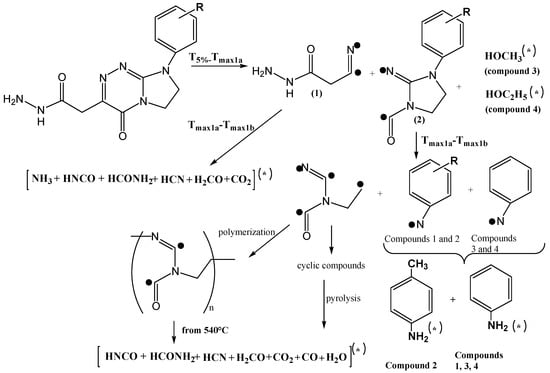
Scheme 1.
The simplified scheme of the pyrolysis course for the tested compounds. (*)—the gaseous products experimentally confirmed based on the FTIR and QMS results. Compounds: 1: R = H; 2: R = 4-CH3; 3: R = 4-OCH3; 4: R = 4-OC2H5.
At the second decomposition stage (from a temperature of approx. 540 °C), mainly the emission of HCN (the absorption band at 713 cm−1 and m/z: 27 (HCN+) and 26 (CN+)), HNCO (the absorption bands at 2270–2290 cm−1 and m/z: 43 (HNCO+), 42 (NCO+)), CH3CN (the absorption bands at 2200–2237 cm−1 and m/z: 41 (CH3CN+), 40 (CH2CN+), 39 (CHCN+)), CO2 (the absorption bands at 2300–2365 cm−1 and 669 cm−1 and m/z: 44 (CO2+), H2O (the absorption bands above 3500 cm−1 and m/z: 18 (H2O+), 17 (HO+)), CO (m/z: 28 (CO+)), HCONH2 (m/z: 45 (HCONH2+)) and H2CO (m/z: 30 (H2CO+) is observed []. The type of gaseous decomposition products at the second decomposition stage suggests the pyrolysis of the remaining adduct formed from the residue after the removal of the H2N-NH-CO-CH2-C•=N• and an aromatic group from the initial compounds (an adduct formed in the polymerisation process) or the pyrolysis process of the formed cyclic compounds, as is presented in Scheme 1.
2.4. TG/DTG Analyses (Oxidative Conditions)
The course of the TG, DTG and DSC curves for the tested compounds collected in oxidative conditions is presented in Figure 6. Table 4 shows the results read from the TG and DTG curves. This analysis confirms a high thermal stability of the investigated molecules in the presence of oxygen. All the compounds start to decompose at temperatures higher than 230 °C, i.e., at temperatures significantly above room temperature. In light of the results of studies on the kinetics of thermal decomposition, storing highly thermally stable pharmaceuticals at temperatures from 25 to 40 °C under air atmosphere is not associated with the risk of losing their shelf life [,]. Among all annelated triazinylacetohydrazides, compound 4, containing the para-ethoxy group at the phenyl moiety, is the most thermally stable. Its decomposition begins at 254 °C. The analysed compounds are less thermally resistant in an oxidising atmosphere compared to in an inert atmosphere. However, this is an expected situation because oxygen interacts with these compounds at elevated temperatures, resulting in a decrease in decomposition activation energy. Similarly to in the inert atmosphere, TG/DTG results indicate that the decomposition of the investigated molecules in the presence of air is a complicated process in which individual elementary reactions overlap. In general, it can be said that the tested compounds decompose in three main stages under oxidising conditions, marked as Tmax1/Tmax1a, Tmax2 and Tmax3. The first decomposition stage is composed of few steps. It starts from T5% and ends at temperatures of approx. 380–410 °C. The mass loss is from 27% to 47%. The second decomposition stage from approx. 380–410 °C to approx. 470–480 °C, with the mass loss from 10% to 21%, is visible. Finally, the third decomposition stage spreads from 470–480 °C to 740 °C with the mass loss above 42%. All analysed compounds, when heated to 750 °C, decompose completely in an oxidising atmosphere. Due to the presence of oxygen, it is expected that the decomposition process will be more complicated than in an atmosphere without oxygen, which will result in a greater variety of gaseous decomposition products. These results are also confirmed by the DSC analysis. As is well seen, both endothermic and exothermic signals are observed on the DSC curves, Figure 6. The beginning of the first decomposition stage of the tested compounds is related to the occurrence of endothermic DSC signals, which describe the process of breaking the bonds present in their structure. As the heating temperature increases, the appearance of exothermic DSC peaks is visible. It confirms that the decomposition of the investigated compounds is more complicated in an air atmosphere. It includes both pyrolysis processes and reactions with oxygen.
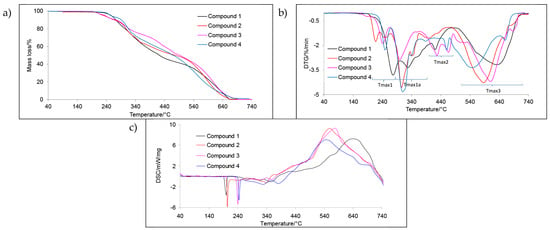
Figure 6.
The course of the TG (a), DTG (b) and DSC (c) curves for the tested compounds (oxidative conditions).

Table 4.
The TG/DTG data for the tested compounds (oxidising conditions).
2.5. Decomposition Course of the Tested Compounds Evaluated with the Use of Simultaneous TG/FTIR/QMS Method (Oxidative Conditions)
Figure 7 shows the gaseous FTIR spectra obtained during heating of the tested annelated triazinylacetohydrazides and collected at Tmax1, Tmax1a, Tmax2 and Tmax3 in oxidative conditions.
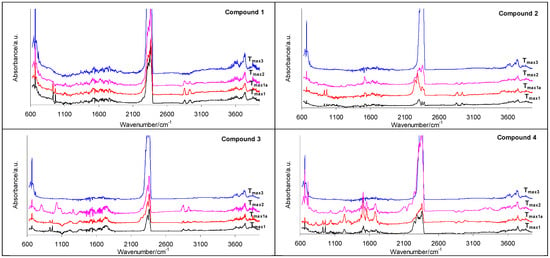
Figure 7.
The gaseous FTIR spectra collected at Tmax1, Tmax1a, Tmax2 and Tmax3 (oxidative conditions).
As is well visible, from T5% to Tmax1a, the emission of NH3 due to the presence of two characteristic absorption bands at 931 cm−1 and at 966 cm−1, describing the deformation vibrations of N–H groups [,,,] at the gaseous FTIR spectra, and m/z ions 15 (NH+) and 17 (NH3+) at the QMS spectra is clearly confirmed. Together with the ammonia, the creation of some of the nitrogen oxides is documented. The emission of NO2 as a result of oxidation of ammonia [,,] extends from T5% to 490 °C (the first low emission). The second, high emission of nitrogen oxides with a maximum intensity occurs at Tmax3. The formation of these nitrogen oxides is confirmed by the m/z ion 30 (NO+) at the QMS spectra and the presence of the absorption bands at 1630 cm−1 at the FTIR spectra. Also, the emission of HNCO starts at T5%, and it is well visible up to temperatures of 800 °C with two clearly marked maxima at Tmax1a and Tmax3. This emission is illustrated by the presence of absorption bands at 2270–2290 cm−1, partially obscured by absorption bands for CO2 and m/z ions 43 (HNCO+) and 42 (NCO+). However, the emission of HCN (FTIR: the absorption signal at 713 cm−1; m/z: 27 (HCN+) and 26 (CN+)) from ca. Tmax2 is recorded. Together with the emission of the above-mentioned gases, the emission of CO2 (m/z: 44 (CO2+) and H2O (FTIR: m/z ions: 18 (H2O+), 17 (HO+)) is observed.
It is noteworthy that no alcohol formation as a result of the detachment of alkoxy groups from the aromatic ring in the case of compounds 3 and 4 under oxidising conditions is observed. This confirms that alcohols (methanol and ethanol) as intermediate products are oxidised to aldehydes (formaldehyde and acetaldehyde) [,,]. The formed aldehydes can be further oxidised to the corresponding acids that may undergo decarboxylation under the conditions of the experiment [,,]. The absorption bands at 1710–1745 cm−1 confirm the creation of some carbonyl-type compounds as a result of the cleavage of the bonds present in the structure of the tested compounds (formamide, formaldehyde) and as a result of the oxidation of alcohols (formaldehyde and acetaldehyde). In addition, the QMS spectra prove the creation of aldehyde fragments by the presence of the characteristic m/z ions: 29 (CHO+), 30 (H2CO+), 44 (CH3CHO+) and 45 (HCONH2+).
From the temperature of Tmax1a to Tmax2, the clear emission of some aromatic compounds, based on the presence of the absorption bands at 700–815 cm−1 (the out-of-plane deformation vibrations of the N–H and the CAr-H), 1234–1278 cm−1 (the stretching vibrations of the C–N), 1500–1560 cm−1 (the stretching vibrations of the CAr=CAr), 1619–1675 cm−1 (the deformation vibrations of the N–H), 2842–2925 cm−1 (the stretching vibrations of the C–H) and 3000–3070 cm−1 (the stretching vibrations of the CAr-H), is visible [,,]. Their intensity is lower as compared to their emission in inert conditions, which may indicate their partial combustion in the presence of air atmosphere [,].
Above 500 °C, with the maximum at ca. 550 °C, the evaporation of HNCO, HCN, HCONH2 and H2O is clearly visible from the FTIR and QMS spectra, Figure 7 and Figure 8. When the temperature increases above 550 °C, the formation of the gaseous decomposition products such as NO2 (m/z 30), CO2 (m/z 44) and cyanogen (C2N2, m/z 52) [,,], with the maximum intensity at ca. 640 °C, is observed.
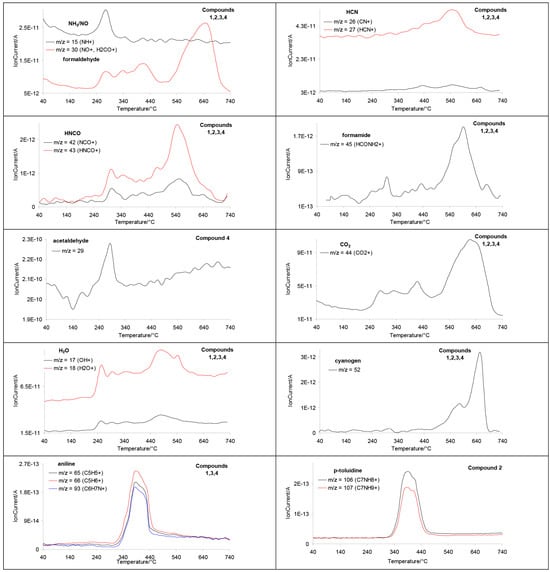
Figure 8.
The exemplary QMS spectra of volatiles formed during oxidative decomposition of the tested compounds.
The obtained results indicate the reactions between gaseous decomposition products resulting from the breaking of the bonds present in the structure of the tested compounds and oxygen. In particular, these are reactions between ammonia and oxygen leading to nitrogen oxides and water. It is also worth mentioning the reaction between hydrogen cyanide and oxygen, which leads to isocyanic acid and cyanogen being obtained at higher temperatures [,,]. The maximum emission of HNCO above 500 °C is visible. In turn, the maximum emission of HNCO at ca. 340–350 °C in an inert atmosphere is confirmed. However, the cyanogen is emitted at temperatures above 550 °C, as is proved based on the performed analyses. Moreover, no alcohol emission and lower emission of aromatic compounds confirm the oxidation and combustion reactions of volatiles. A simplified diagram of possible reactions when heating the tested compounds in the presence of oxidising atmosphere is given in Scheme 2. This scheme presents only a very simplified reaction course. In the case of decomposition in the presence of oxygen, many simultaneous radical reactions between volatiles and oxygen in a gas phase are highly expected. They lead to uncontrolled radical reactions, during which various derivatives with smaller and higher molecular masses can be created and undergo oxidative decomposition and combustion.
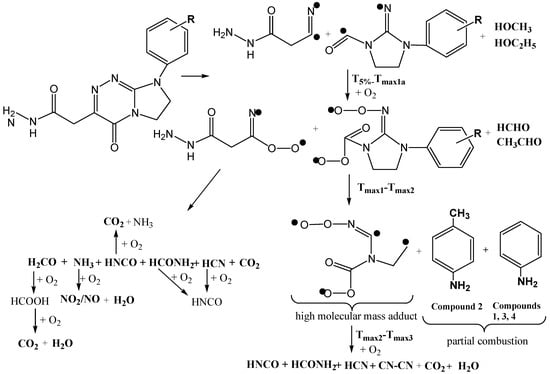
Scheme 2.
The simplified oxidising decomposition course of the tested compounds. Compounds: 1: R = H; 2: R = 4-CH3; 3: R = 4-OCH3; 4: R = 4-OC2H5.
3. Materials and Methods
3.1. Differential Scanning Calorimetry (DSC)
The DSC method (a DSC 204, Netzsch, Selb, Germany) was applied in order to evaluate the course of the melting of the tested compounds. The samples were heated from 20 °C to 260 °C in aluminium crucibles with a pierced lid with a heating rate of 10 K min−1 and in argon atmosphere (a flow rate of 40 mL min−1). The onset (Tonset), peak maximum (Tmax) melting temperatures and the melting enthalpy (ΔH) were determined from the obtained DSC curves.
3.2. Simultaneous Thermogravimetric Analysis Coupled on-Line with FTIR and QMS Analysers (TG/DTG/FTIR/QMS)
Simultaneous TG/DTG analysis (a STA 449 Jupiter F1 instrument Netzsch, Selb, Germany) coupled on-line with FTIR and QMS analysers to estimate thermal properties, such as the thermal stability, decomposition stages and mass losses, as well as the course of pyrolysis and oxidative decomposition, was used. The tested samples from 40 °C to 900 °C in open Al2O3 crucibles with a heating rate of 10 K min−1 and in helium (a flow rate of 40 mL min−1) and in synthetic air (a flow rate of 100 mL min−1) were heated. The DSC/TG Cp S sample carrier was used. The 5% of mass loss (T5%), maximum decomposition temperatures (Tmax) and mass loss (Δm) were estimated.
FTIR TGA 585 r (Bruker, Mannheim, Germany) and a QMS 403 C Aëolos (Netzsch, Selb, Germany) analysers were used to evaluate the type of emitted volatiles in both furnace atmospheres. An FTIR TGA 585 analyser with an IR cell heated to 200 °C was connected on-line to an STA instrument by a Teflon transfer line with a diameter of 2 mm heated to 200 °C. The gaseous FTIR spectra in the wavenumber range of 600–4000 cm−1 and with a resolution of 4 cm−1 and 32 scans per spectrum were collected. A QMS analyser operated under electron ionisation of 70 eV was connected on-line to an STA instrument by quartz capillary heated to 300 °C. The formed m/z ions were collected from 10 amu to 150 amu. In each heating cycle, the QMS spectra at a time interval of 0.6 min (every 6.1 °C) were collected.
4. Conclusions
The DSC and TG/DTG/FTIR/QMS methods have been applied to evaluate the thermal stability and course of the melting process, pyrolysis and oxidative decomposition for annelated triazinylacetic acid hydrazides with prospective medical use. Compounds which are unsubstituted and substituted at the para position of the phenyl moiety were subjected to detailed thermal studies. It was found that melting points, melting enthalpy values and thermal stabilities of the tested compounds changed depending on the type of substituent. Molecules with an alkoxy group (-OC2H5 or -OCH3) were characterised by the highest melting points, with Tmax at 254 °C and 243 °C, respectively. In turn, the unsubstituted compound and its derivative containing the para-CH3-substituted phenyl ring showed the lowest melting points with Tmax at 205 °C and 208 °C, respectively. The change in their thermal stability depending on the used atmosphere was analogical. The highest thermal stability (in both atmospheres) revealed the compound substituted by the para-OC2H5 group. It was thermally stable up to 272 °C under inert conditions and up to 254 °C under oxidative conditions. In turn, the lowest thermal resistance was observed for the compound bearing the para-CH3 group (238 °C and 230 °C in inert and oxidative conditions, respectively). The obtained results clearly indicated that all the analysed annelated triazinylacetohydrazides in the experimental conditions used revealed the enthalpy values necessary for their melting in the range of 209.4–275.3 J/g, did not undergo polymorphic transformations during their melting and proved to be materials with high thermal stability. Thus, when assessing the therapeutic usefulness of these potential drugs, their high thermal stability and favourable thermal properties should be taken into account. In both atmospheres, the decomposition process of annelated triazinylacetohydrazides included several stages that were not well divided. The identified volatiles with the use of the simultaneous TG/FTIR/QMS analyses indicated that the pyrolysis and oxidative decomposition proceeded by a radical mechanism. In inert conditions, the formation of NH3, HCN, HNCO, HCONH2, HCHO, CO2, CO and H2O (for all the tested compounds) and para-toluidine (for the compound with the para-CH3 substitution) and the emissions of aniline and alcohol such as methanol or ethanol (for compounds bearing para-OCH3 and para-OC2H5 substitutions) were confirmed. This indicated the cleavage of C–N and N–N bonds in the triazine ring and resulted in the formation of the radical fragments. These radicals reacted with each other and broke down into fragments with lower molecular masses, detected by the FTIR and QMS analysers. In turn, in oxidative conditions, the mixture of volatiles NH3, HCN, NO, HNCO, HCONH2, CO2, H2O and cyanogen (for all the compounds), para-toluidine (for the compound bearing the para-CH3 substituent), aniline (for unsubstituted, para-OCH3 and para-OC2H5 substituted compounds) and acetaldehyde (for the compound with the para-OC2H5 group) was clearly observed. The additional release of nitrogen oxides and cyanogen and the lack of the emission of alcohols proved the reactions of initially formed volatiles (in particular, NH3, HCN, HNCO and alcohols) with oxygen and thus the more complicated mechanism of oxidative decomposition of the tested compounds compared to their pyrolysis in inert conditions.
We believe that this study will contribute to the understanding of the thermal decomposition mechanism and course of these pharmacologically important heterocyclic molecules and their thermal properties. We hope that the results obtained will be of practical importance, as they will enable determination of the optimal storage conditions for these potential pharmaceuticals and will allow application of filters capturing volatile degradants generated during their thermal disposal.
Author Contributions
Conceptualisation, M.W., K.S. and M.S.; methodology, M.W., K.S. and M.S.; investigation, M.W.; resources, M.W, K.S. and M.S.; writing—original draft preparation, M.W., K.S. and M.S.; writing—review and editing, M.W., K.S. and M.S.; funding acquisition, K.S. All authors have read and agreed to the published version of the manuscript.
Funding
This research received no external funding.
Institutional Review Board Statement
Not applicable.
Informed Consent Statement
Not applicable.
Data Availability Statement
The data presented in this study are available on request from the authors.
Conflicts of Interest
The authors declare no conflict of interest.
References
- Sztanke, M.; Sztanke, K. Biologically important hydrazide-containing fused azaisocytosines as antioxidant agents. Redox Rep. 2017, 22, 572–581. [Google Scholar] [CrossRef] [PubMed]
- Kumar, R.; Sirohi, T.S.; Singh, H.; Yadav, R.; Roy, R.K.; Chaudhary, A.; Pandeya, S.N. 1,2,4-triazine analogs as novel class of therapeutic agents. Mini Rev. Med. Chem. 2014, 14, 168–207. [Google Scholar] [CrossRef] [PubMed]
- Zálešák, F.; Slouka, J.; Stýskala, J. General synthesis of 1-aryl-6-azaisocytosines and their utilization for the preparation of related condensed 1,2,4-triazines. Molecules 2019, 24, 3558. [Google Scholar] [CrossRef] [PubMed]
- Congreve, M.; Andrews, S.P.; Doré, A.S.; Hollenstein, K.; Hurrell, E.; Langmead, C.J.; Mason, J.S.; Ng, I.W.; Tehan, B.; Zhukov, A.; et al. Discovery of 1,2,4-triazine derivatives as adenosine A2A antagonists using structure based drug design. J. Med. Chem. 2012, 55, 1898–1903. [Google Scholar] [CrossRef] [PubMed]
- Mahindra, A.; Jenkins, L.; Marsango, S.; Huggett, M.; Huggett, M.; Robinson, L.; Gillespie, J.; Rajamanickam, M.; Morrison, A.; McElroy, S.; et al. Investigating the Structure-Activity Relationship of 1,2,4-Triazine G-Protein-Coupled Receptor 84 (GPR84) Antagonists. J. Med. Chem. 2022, 65, 11270–11290. [Google Scholar] [CrossRef] [PubMed]
- Moura Ramos, J.J.; Diogo, H.P. Calorimetric (DSC) and dielectric (TSDC) investigation on the thermal behavior and molecular mobility in the supercooled liquid and glassy states of bifonazole and lamotrigine. J. Therm. Anal. Calorim. 2021, 145, 3077–3085. [Google Scholar] [CrossRef]
- Fasihi, Z.; Zakeri-Milani, P.; Nokhodchi, A.; Akbari, J. Thermodynamic approaches for the prediction of oral drug absorption. J. Therm. Anal. Calorim. 2017, 130, 1371–1382. [Google Scholar] [CrossRef]
- Attia, A.K.; Souaya, E.R.; Soliman, E.A. Thermal analysis investigation of dapoxetine and vardenafil hydrochlorides using molecular orbital calculations. Adv. Pharm. Bull. 2015, 5, 523–529. [Google Scholar] [CrossRef][Green Version]
- Epishina, M.A.; Kulikov, A.S.; Fershtat, L.L. Revisiting the synthesis of functionally substituted 1,4-dihydrobenzo[e][1,2,4]triazines. Molecules 2022, 27, 2575. [Google Scholar] [CrossRef]
- Worzakowska, M.; Sztanke, M.; Sztanke, K. Decomposition mechanism of annelated triazinones bearing the para-nitrophenyl group. J. Anal. Appl. Pyrolysis 2020, 149, 104856. [Google Scholar] [CrossRef]
- Ostasz, A.; Łyszczek, R.; Sztanke, K.; Sztanke, M. TG-DSC and TG-FTIR Studies of Annelated Triazinylacetic Acid Ethyl Esters—Potential Anticancer Agents. Molecules 2023, 28, 1735. [Google Scholar] [CrossRef] [PubMed]
- Worzakowska, M.; Sztanke, M.; Sztanke, K. Pyrolysis and oxidative decomposition mechanism of trifluoromethylated fused triazinones. J. Anal. Appl. Pyrolysis 2021, 157, 105226. [Google Scholar] [CrossRef]
- Yar, M.; Sidra, L.R.; Pontiki, E.; Mushtaq, N.; Ashraf, M.; Nasar, R.; Khan, I.U.; Mahmood, N.; Naqvi, S.A.R.; Khan, Z.A.; et al. Synthesis, in vitro lipoxygenase inhibition, docking study and thermal stability analyses of novel indole derivatives. Non-isothermal kinetic study of potent LOX inhibitor N’-(diphenylmethylene)-2-(1H-indole-3-yl)acetohydrazide. J. Iran. Chem. Soc. 2014, 11, 369–378. [Google Scholar] [CrossRef]
- Emara, E.M.; El-Sayed, W.A.; Khalaf-Allah, A.S.A.; Alminderej, F.M.; Abdel-Monem, Y.K.; Abd-Rabou, A.A. Spectral studies, thermal investigations, and anticancer activity of some divalent metal complexes derived from 2-(4-bromophenylamino)acetohydrazide ligand. Appl. Organomet. Chem. 2022, 36, e6657. [Google Scholar] [CrossRef]
- Cai, Y.-H. Synthesis, morphology and theoretical calculations of 1H-benzotriazole-acetohydrazide. J. Chem. Pharm. Res. 2014, 6, 673–678. [Google Scholar]
- Abdel-Monem, Y.K.; Emam, S.M.; Okda, H.M.Y. Solid state thermal decomposition synthesis of CuO nanoparticles from coordinated pyrazolopyridine as novel precursors. J. Mater. Sci. Mater. Electron. 2017, 28, 2923–2934. [Google Scholar] [CrossRef]
- Wesolowski, M.; Leyk, E. Coupled and Simultaneous Thermal Analysis Techniques in the Study of Pharmaceuticals. Pharmaceutics 2023, 15, 1596. [Google Scholar] [CrossRef]
- Bondarchuk, S.V. On prediction of melting points without computer simulation: A focus on energetic molecular crystals. FirePhysChem. 2022, 2, 160–167. [Google Scholar] [CrossRef]
- Liu, Z. Review and prospect of thermal analysis technology applied to study thermal properties of energetic materials. FirePhysChem. 2021, 1, 129–138. [Google Scholar] [CrossRef]
- Hogge, J.W.; Long, E.A.; Christian, M.L.; Fankhauser, A.D.; Quist, N.L.; Rice, D.M.; Wilding, W.V.; Knotts, T.A. Melting point, enthalpy of fusion, and heat capacity measurements of several polyfunctional, industrially important compounds by differential scanning calorimetry. J. Chem. Eng. Data 2018, 63, 2500–2511. [Google Scholar] [CrossRef]
- Lanyi, F.J.; Wenzke, N.; Kaschta, J.; Schubert, D.W. On the Determination of the Enthalpy of Fusion ofα-Crystalline Isotactic Polypropylene Using Differential Scanning Calorimetry, X-Ray Diffraction, and Fourier-Transform Infrared Spectroscopy: An Old Story Revisited. Adv. Eng. Mater. 2020, 22, 1900796. [Google Scholar] [CrossRef]
- NIST Chemistry Webbook. NIST Standard Reference Data. 2011. Available online: https://webbook.nist.gov (accessed on 2 November 2023).
- Koltsov, I. Thermal stability of polymeric carbon nitride (PCN)-Al2O3-ZrO2 nanocomposites used in photocatalysis. J. Therm. Anal. Calorim. 2022, 147, 7675–7682. [Google Scholar] [CrossRef]
- Jiang, X.; Li, C.; Chi, Y.; Yan, J. TG-FTIR study on urea-formaldehyde resin residue during pyrolysis and combustion. J. Hazard. Mater. 2010, 173, 205–210. [Google Scholar] [CrossRef] [PubMed]
- Wojtas, J.; Szala, M. Thermally enhanced FTIR spectroscopy applied to study of explosives stability. Measurement 2021, 184, 110000. [Google Scholar] [CrossRef]
- Zhou, J.G.; Gao, P.; Dong, C.G.; Yang, Y.P. TG-FTIR analysis of nitrogen conversion during straw pyrolysis: A model compound study. J. Fuel Chem. Technol. 2015, 43, 1427–1432. [Google Scholar] [CrossRef]
- Zhai, P.; Shi, C.; Zhao, S.; Liu, W.; Wang, W.; Yao, L. Thermal decomposition of ammonium perchlorate-based molecular perovskite from TG-DSC-FTIR-MS and ab initio molecular dynamics. RSC Adv. 2021, 11, 16388–16395. [Google Scholar] [CrossRef] [PubMed]
- Xu, L.; Che, L.; Zheng, J.; Huang, G.; Wu, X.; Chen, P.; Zhang, L.; Hu, Q. Synthesis and thermal degradation property study of N-vinylpyrrolidone and acrylamide copolymer. RSC Adv. 2014, 4, 33269–33278. [Google Scholar] [CrossRef]
- Sivabalan, R.; Talawar, M.B.; Senthilkumar, N.; Kavitha, B.; Asthana, S.N. Studies on azotetrazolate based high nitrogen content high energy materials potential additives for rocket propellants. J. Therm. Anal. Calorim. 2004, 78, 781–792. [Google Scholar] [CrossRef]
- Rishwana, S.S.; Mahendran, A.; Vijayakumar, C.T. Studies on structurally different benzoxazines based on diphenols and diamines: Kinetics of thermal degradation and TG-FTIR studies. Thermochim. Acta 2015, 618, 74–87. [Google Scholar] [CrossRef]
- Tudorachi, N.; Mustata, F.; Bicu, I. Thermal decomposition of some Diels-Alder adducts of resin acids. Study of kinetics process. J. Anal. Appl. Pyrolysis 2012, 98, 106–114. [Google Scholar] [CrossRef]
- Available online: https://webbook.nist.gov/cgi/cbook.cgi?ID=C62533&Mask=200#Mass-Spec (accessed on 3 November 2023).
- Garrigues, J.M.; Perez-Ponce, A.; Garrigues, S.; Guardia, M. Direct determination of ethanol and methanol in liquid samples by means of vapor phase-Fourier transform infrared spectroscopy. Vib. Spectrosc. 1997, 15, 219–228. [Google Scholar] [CrossRef]
- Liu, Z.; Luan, Y.; Sun, X. Thermogravimetry-Infrared spectroscopy analysis of the pyrolysis of willow leaves, stems and branchers. Adv. Mater. Sci. Eng. 2015, 2015, 303212. [Google Scholar] [CrossRef]
- Fasina, O.; Littlefield, B. TG-FTIR of pecan shells thermal decomposition. Fuel Proc. Tech. 2012, 102, 61–66. [Google Scholar] [CrossRef]
- Shamsipur, M.; Pourmortazavi, S.M.; Beigi, A.A.M.; Heydari, R.; Khatibi, M. Thermal stability and decomposition kinetic studies of acyclovir and zidovudine drug compounds. AAPS PharmSciTech 2013, 14, 287–293. [Google Scholar] [CrossRef] [PubMed]
- Yoshida, M.I.; Gomes, E.C.; Soares, C.D.; Oliveira, M.A. Thermal behavior study and decomposition kinetics of amiodarone hydrochloride under isothermal conditions. Drug Dev. Ind. Pharm. 2011, 37, 638–647. [Google Scholar] [CrossRef] [PubMed]
- Drummond, L.J. High temperature oxidation of ammonia. Combust. Sci. Technol. 1972, 5, 175–182. [Google Scholar] [CrossRef]
- Mathieu, O.; Petersen, E.L. Experimental and modelling study on the high-temperature oxidation of ammonia and related NOx chemistry. Combust. Flame 2015, 162, 554–570. [Google Scholar] [CrossRef]
- Holden, S.R.; Zhang, Z.; Gao, J.; Wu, J.; Zhang, D. An experimental observation of the thermal effects and NO emissions during dissociation and oxidation of ammonia in the presence of a bundle of thermocouples in a vertical flow reactor. Adv. Chem. Eng. Sci. 2023, 13, 250–264. [Google Scholar] [CrossRef]
- Cullis, C.F.; Newitt, E.J. The gaseous oxidation of aliphatic alcohols. I. Ethyl alcohol: The products formed in the early stages. Proc. R. Soc. Lond. A 1956, 237, 530–542. [Google Scholar]
- Taylor, P.; Shanbhag, S.; Dellinger, B. The high-temperature pyrolysis and oxidation of methanol and ethanol: Experimental results and comparison with vehicle emission tests. J. Fuels Lubr. 1994, 103, 982–992. [Google Scholar]
- Dunphy, M.P.; Simmie, J.M. High-temperature oxidation of ethanol. Part 1.—Ignition delays in shock waves. J. Chem. Soc. Faraday Trans. 1991, 87, 1691–1696. [Google Scholar] [CrossRef]
- Baldwin, R.R.; Langford, D.H.; Matchan, M.J.; Walker, R.W.; Yorke, D.A. The high-temperature oxidation of aldehydes. Symp. (Int.) Combust. 1971, 13, 251–259. [Google Scholar] [CrossRef]
- Zhang, Y.; Chen, Y.; Cai, H.; He, S.; Shan, O.; Zhao, H.; Chen, Y.; Wang, B. Catalyst-free aerobic oxidation of aldehydes into acids in water under mild conditions. Green Chem. 2017, 19, 5708–5713. [Google Scholar] [CrossRef]
- Pelucchi, M.; Namysl, S.; Ranzi, E.; Frassoldati, A.; Herbinet, O.; Battin-Leclerc, F.; Faravelli, T. An experimental and kinetic modelling study of n-C4-C6 aldehydes oxidation in a jet-stirred reactor. Proc. Combust. Inst. 2019, 37, 389–397. [Google Scholar] [CrossRef]
- Jin, H.; Yuan, W.; Li, W.; Yang, J.; Zhou, Z.; Zhao, L.; Li, Y.; Qi, F. Combustion chemistry of aromatic hydrocarbons. Prog. Energy Combust. Sci. 2023, 96, 101076. [Google Scholar] [CrossRef]
- Burgoyne, J.H. The combustion of aromatic and alicyclic hydrocarbons. V. The products of combustion of benzene and its monoalkyl derivatives. Proc. R. Soc. Lond. A 1940, 175, 539–563. [Google Scholar]
- Madarasz, J.; Varga, P.P.; Pokol, G. Evolved gas analyses (TG/DTA-MS and TG-FTIR) on dehydration and pyrolysis of magnesium nitrate hexahydrate in air and nitrogen. J. Anal. Appl. Pyrolysis 2007, 79, 475–478. [Google Scholar] [CrossRef]
- Schuster, J.; Zmrhalova, Z.; Pelikan, V.; Matyas, R. Thermal decomposition mechanism of cuprous thiocyanate in the presence of synthetic air and nitrogen gas. SSRN Electron. J. 2022. [Google Scholar] [CrossRef]
- Available online: https://webbook.nist.gov/cgi/cbook.cgi?ID=C460195&Mask=200#Mass-Spec (accessed on 3 November 2023).
- Dagaut, P.; Glarborg, P.; Aluzeta, M.U. The oxidation of hydrogen cyanide and related chemistry. Prog. Energy Combust. Sci. 2008, 34, 1–46. [Google Scholar] [CrossRef]
- Glarborg, P.; Miller, J.A. Mechanism and modeling of hydrogen cyanide oxidation in a flow reactor. Combust. Flame 1994, 99, 475–483. [Google Scholar] [CrossRef]
- Higashihara, T.; Saito, K.; Murakami, I. Oxidation of hydrogen cyanide in shock waves. Formation of nitrogen monoxide. J. Phys. Chem. 1983, 87, 3707–3712. [Google Scholar] [CrossRef]
Disclaimer/Publisher’s Note: The statements, opinions and data contained in all publications are solely those of the individual author(s) and contributor(s) and not of MDPI and/or the editor(s). MDPI and/or the editor(s) disclaim responsibility for any injury to people or property resulting from any ideas, methods, instructions or products referred to in the content. |
© 2024 by the authors. Licensee MDPI, Basel, Switzerland. This article is an open access article distributed under the terms and conditions of the Creative Commons Attribution (CC BY) license (https://creativecommons.org/licenses/by/4.0/).